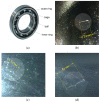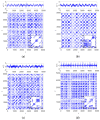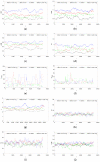Ball Bearing Fault Diagnosis Using Recurrence Analysis
- PMID: 36079322
- PMCID: PMC9457464
- DOI: 10.3390/ma15175940
Ball Bearing Fault Diagnosis Using Recurrence Analysis
Abstract
This paper presents the problem of rolling bearing fault diagnosis based on vibration velocity signal. For this purpose, recurrence plots and quantification methods are used for nonlinear signals. First, faults in the form of a small scratch are intentionally introduced by the electron-discharge machining method in the outer and inner rings of a bearing and a rolling ball. Then, the rolling bearings are tested on the special laboratory system, and acceleration signals are measured. Detailed time-dependent recurrence methodology shows some interesting results, and several of the recurrence indicators such as determinism, entropy, laminarity, trapping time and averaged diagonal line can be utilized for fault detection.
Keywords: bearing defect; diagnosis; recurrence plot; recurrence quantifications.
Conflict of interest statement
The authors declare no conflict of interest.
Figures









References
-
- Liu Q., Guo Y. Dynamic model of faulty rolling element bearing on double impact phenomenon; Proceedings of the 2015 IEEE International Conference on Information and Automation; Lijiang, China. 8–10 August 2015; pp. 2017–2021. - DOI
-
- Patil M., Mathew J., Rajendrakumar P., Desai S. A theoretical model to predict the effect of localized defect on vibrations associated with ball bearing. Int. J. Mech. Sci. 2010;52:1193–1201. doi: 10.1016/j.ijmecsci.2010.05.005. - DOI
-
- Petersen D., Howard C., Sawalhi N., Moazen Ahmadi A., Singh S. Analysis of bearing stiffness variations, contact forces and vibrations in radially loaded double row rolling element bearings with raceway defects. Mech. Syst. Signal Process. 2015;50–51:139–160. doi: 10.1016/j.ymssp.2014.04.014. - DOI
-
- Saucedo-Dorantes J.J., Zamudio-Ramirez I., Cureno-Osornio J., Osornio-Rios R.A., Antonino-Daviu J.A. Condition Monitoring Method for the Detection of Fault Graduality in Outer Race Bearing Based on Vibration-Current Fusion, Statistical Features and Neural Network. Appl. Sci. 2021;11:8033. doi: 10.3390/app11178033. - DOI
-
- Moazen Ahmadi A., Petersen D., Howard C. A nonlinear dynamic vibration model of defective bearings—The importance of modelling the finite size of rolling elements. Mech. Syst. Signal Process. 2015;52–53:309–326. doi: 10.1016/j.ymssp.2014.06.006. - DOI
Grants and funding
LinkOut - more resources
Full Text Sources

